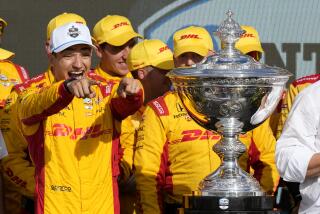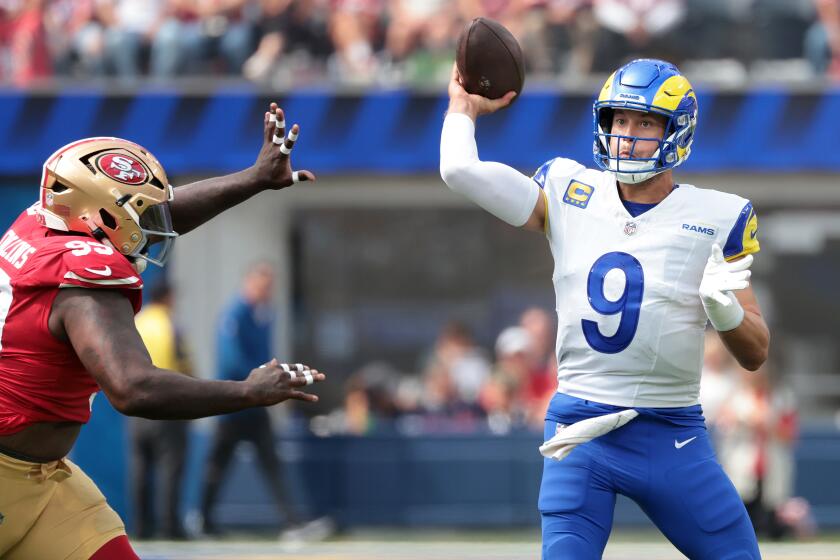Blame in Death of Earnhardt Shifts to Belt
- Share via
ROCKINGHAM, N.C. — Dale Earnhardt died after his seat belt broke, NASCAR announced Friday.
The disclosure opened a new investigative avenue into the death of the legendary racing driver, who was killed Sunday when his car hit the Daytona Speedway wall at an estimated 180 mph. Until now, speculation about Earnhardt’s death had centered on the fact that he had not been wearing enough head and neck support to withstand the near head-on collision.
“We don’t know how, why or when,” said Mike Helton, NASCAR president. “But when the rescue people reached him, they found part of the belt loose, on the floor. Somehow, the webbing had separated.”
Gary Nelson, Winston Cup series director, said that neither he nor anyone currently connected with NASCAR had ever seen a lap belt come apart in the series’ 52-year history. He would not reveal if the woven nylon belt had been cut, worn through or was frayed. Nor did he speculate about what caused it to be loose on the floor.
Dr. Steve Bohannon, emergency medical officer at Daytona International Speedway in Daytona Beach, Fla., said that the broken belt could have been a major cause of Earnhardt’s death, which occurred during the final lap of the Daytona 500 race.
“It appears that [Earnhardt] moved forward and to the right, which likely caused his chin to contact the steering wheel with a tremendous impact,” Bohannon said. “No one knows for sure what would have happened if that belt held, but he probably would not have made contact with the steering column.”
Earnhardt, 49, died instantly of “blunt force head injuries.” He had a skull fracture that ran from the front of his brain to the back. He also had eight broken ribs, a broken sternum and a broken left ankle.
Separated Belt Called a First
The owner of Earnhardt’s Chevrolet Monte Carlo, Richard Childress, said the car was new, built in November, and its belts were installed at the same time.
“It’s the same belt Dale has worn forever,” Childress said.
Another factor that may have contributed to the fatal accident was Earnhardt’s old-fashioned open-face helmet, now used by a minority of drivers.
“Had Mr. Earnhardt been wearing a full-face helmet, it would have prevented him being hit directly on the chin,” Bohannon said. “I am an advocate of head restraints, but I am not convinced that the HANS device would have made any difference in this case.”
The HANS is a head and neck support device widely discussed as a future preventive measure for such accidents. The majority of drivers on the National Assn. for Stock Car Auto Racing circuit do not wear the HANS device. Only seven wore one during the Daytona 500, but a number of others have said they plan to wear one in this Sunday’s 400-mile race at North Carolina Speedway here.
“Even though the broken belt and the open-face helmet contributed to the blow Mr. Earnhardt took, there still would have been other injuries from such an impact,” Bohannon said.
The belt in question was manufactured by Simpson Safety Products of Mooresville, N.C., a longtime supplier of NASCAR safety equipment. It is part of a multiple restraint system, designed especially for race cars, that includes a shoulder harness that connects in the rear of the vehicle to the chassis.
“It is distressing to lose a good friend and great competitor like Dale Earnhardt,” said Bill Simpson, the company’s owner. “It was also distressing to hear this morning that a seat belt that we produced came apart during his fatal crash.
“Having tested and produced seat belts for the motor sports industry for more than 43 years, we have never seen a seat belt come apart in the manner that occurred. Our seat belts, when properly installed, won’t fail.”
Simpson said his company’s belts were designed to withstand crashes of well over 200 mph.
Helton said that NASCAR will make no rule changes for Sunday’s race. “If we knew there was something that we could do, we’d do it,” he said. “At this point, we don’t have a conclusion. We simply want everyone to know what we found.”
Earnhardt was buried Wednesday in a private service in Kannapolis, N.C., his hometown. On Thursday, thousands of mourners were on hand for memorial services at a nearby church.
Earnhardt’s son, Dale Jr., 26, who finished second in the Daytona 500, announced earlier in the week that he would compete in the race here Sunday.
(BEGIN TEXT OF INFOBOX / INFOGRAPHIC)
Earnhardt’s Broken Seat Belt
Dale Earnhardt’s seat belt apparently broke during the fatal crash at Daytona, possibly contributing to his death. Here’s a look at the five-point seat belt he was wearing, which is used by most NASCAR drivers:
Belts are made to withstand crashes of over 200 mph and stretch a few inches upon impact. Earnhardt hit the wall at about 180 mph.
Earnhardt’s open-face helmet may have been a factor in his death. Many drivers now wear closed-face helmets.
The broken belt may have allowed his body to hurtle forward, forcing his head and chest into the steering wheel.
Nylon belt webbing may have come apart at a buckle near where the belt attaches to the car frame.
(BEGIN TEXT OF INFOBOX / INFOGRAPHIC)
How HANS Could Have Helped
HANS (Head and Neck Support) attaches helmet to seat, preventing excessive head movement. *
Sources: Simpson Safety Products; wire reports. Researched by JULIE SHEER/Los Angeles Times
*
* THE LAST LAP
A closer look at the final moments of the Daytona 500, when NASCAR driver Dale Earnhardt was killed, D1
More to Read
Go beyond the scoreboard
Get the latest on L.A.'s teams in the daily Sports Report newsletter.
You may occasionally receive promotional content from the Los Angeles Times.










